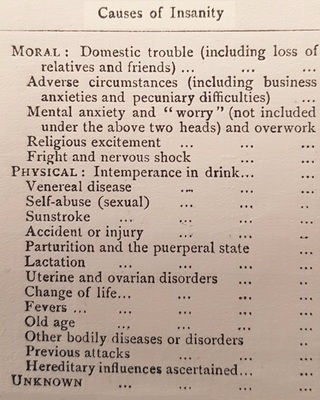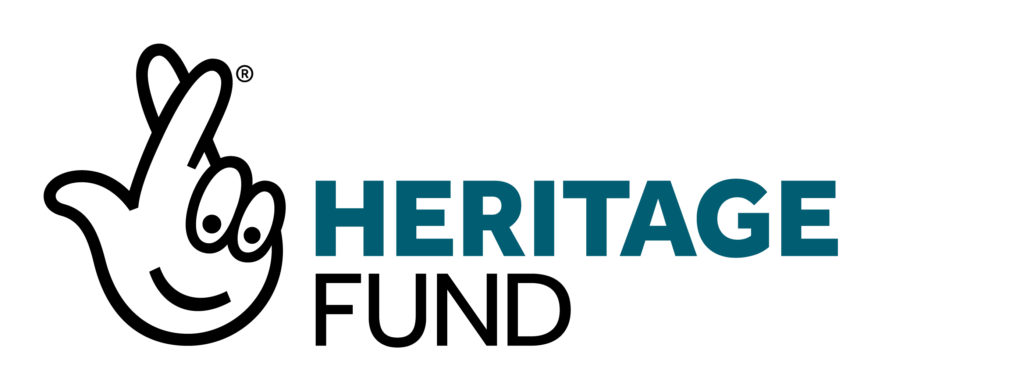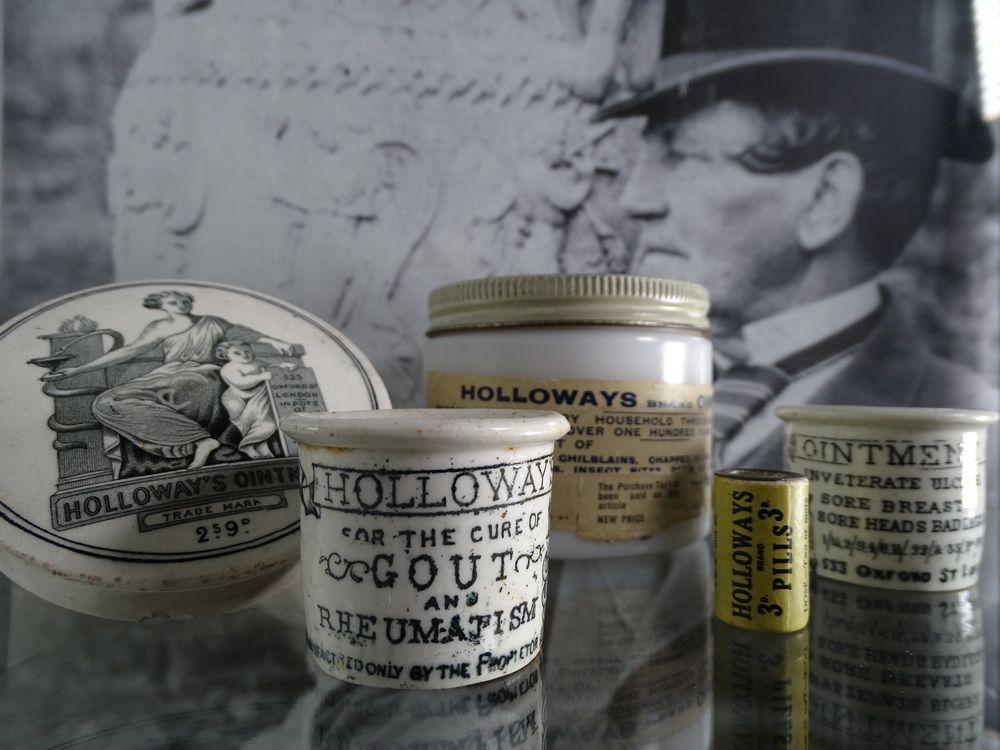Health, Holloway and Hype Part 3
Holloway Sanatorium and Mental Illness pre-1948
Holloway Sanatorium was a place designed to take mental illness out of respectable society in the nineteenth century. The building’s architectural design and interior furnishings were aimed at instilling a sense of wellbeing in the patients.
Classification of Illnesses
The Sanatorium may have been specifically for the middle-classes but those admitted suffered from a wide range of illnesses connected with mental health. The Sanatorium’s Annual Reports from its early days up until its integration with the National Health Service, in 1948, provide an array of data about its patients. These reports include details of patients’ illnesses, if any were discharged, transferred to another asylum or died; whilst early reports detail the occupation of patients, religious affiliation, place and country of residence – a reminder that patients did not need to live locally to be admitted. After all, the Sanatorium was open to those who could pay the fees. Even in 1931, the Annual Report noted a high number of transfers of patents to other mental hospitals “…for financial reasons – it is not policy of the Committee to retain patients indefinitely free or at greatly reduced rates who are incurable and incapable of appreciating their surroundings.”[1]
The textbook, A Handbook for Mental Nurses distinguished between the terms ‘mental deficiency’ and ‘mental disease’, stating it was important to note the difference: “…as far back as the time of Edward I, a distinction was made between the ‘born fool’ and the person who ‘hath had understanding, but by disease, grief, or other accident, hath lost the use of his reason.’”[2] Importantly, it details that mental illness does not necessarily have one cause and that an event/illness may have an (adverse) effect on one patient but not another. The establishment of Holloway Sanatorium, in the late 19th Century, was during a period when mental health was usually seen as either: an inherited disease; due to the patient’s lifestyle; or the side effects of physical illnesses.
Early Sanatorium reports detailed patients’ illnesses under “probable” causes: Moral, such as domestic trouble, adverse circumstances, religious excitement; and Physical, such as intemperance in drink, venereal disease, change of life, hereditary influences. The form in which the illness would manifest itself was also listed. The following are just a handful of the diagnoses of patients’ mental illness as reported in the Sanatorium Annual Reports in the late 19th and early 20th Centuries.

Epilepsy
Insanity and epilepsy were closely related disorders for many centuries, with epileptics suffering from unconsciousness, convulsions and mental disturbances. The Sanatorium, as in other asylums, diagnosed epileptic patients with mental health issues such as insanity or as an inherited or infantile mental deficiency occurring in early life. Advances in medical science meant epileptic seizures could begin to be treated with appropriate medication in the 20th Century but such advances were slow, as were society’s attitudes to those with epilepsy.
General Paralysis of the Insane (GPI)
In the late 19th Century, hundreds of people admitted to asylums were diagnosed with General Paralysis of the Insane (GPI) and many of these were men. The disease’s signs included delusions, a staggering gait, tremulous voice and muscular weakness and the prognosis was not good for these patients.[3] It was only discovered in 1905 that GPI was linked to syphilis. By this time, 1905, 100 patients (51 men, 49 women) had been admitted to the Sanatorium, with 10 male patients diagnosed with GPI.[4] If syphilis was not treated in its early stages, patients would initially suffer with fatigue, headaches and insomnia. As the disease progressed, mental deterioration and personality changes occurred. It was only the advent of penicillin in 1928 that saw the incidences of GPI fall.
Hysteria or “nerves”
Hysteria, from the ancient Greek word for uterus, has been associated with women since Plato’s time. In the 19th Century, it was used to describe a number of female ailments such as infertility, PTSD, depression and menopause. In addition, during the 1800s, women’s role in society was restricted and revolved around the home and family as a respectable wife and mother but this could lead to anxiety and depression for some individuals. By the late 1880s, American neurologist Silas Weir Mitchell believed hysteria was caused by overstimulation of the mind. Sigmund Freud believed that when traumatic memories were repressed, the physical hysterical symptoms developed as a result.
Moral insanity
Moral insanity became an accepted diagnosis during the 19th Century. The implications were that a patient may be fully aware of their surroundings with no hallucinations but may have violent behaviour or emotions. Originally, the term ‘moral’ was taken from the French to refer to something being emotional, rather than the modern day meaning of ethics. Under this term, the Sanatorium admitted patients suffering from domestic problems, adverse circumstances, mental anxiety and ‘worry’, religious excitement, or fright and nervous shock.[5]

Treatments
Holloway Sanatorium was a place to take the mentally ill out of respectable society and the Sanatorium aspired “to incessantly apply in all cases constant psychological and physical treatment with a view to stimulating a return to a healthy state of mind”.[6] Its architectural design and interior furnishings made the Sanatorium appear as a stately home, rather than as a hospital, and aimed to instil a sense of wellbeing for inmates as they strolled the grounds or read a book from the library.
However, there were still treatments to help treat and cure patients. Restraints were used to protect patients including mechanical restraints, such as straps, in order to stop patients injuring themselves or others. Despite national concerns about the potential for abuse by staff, such practice continued into the 20th Century with the Sanatorium’s Reports noting if any patients had been placed in restraints during the year. Seclusion was also a form of restraint with which to confine inmates in a room they could not exit; and there were also padded cells for inmates, which provided a place of safety for individuals.
Medication and surgical procedures were used where appropriate as the 20th Century progressed. The 1930s saw the introduction of cardiazol for schizophrenic patients and, initially, it was believed it would provide relief from symptoms, if not cure patients. Furthermore, the 1940s saw electric shock used solely or in conjunction with a modified insulin shock method for those in depressed states and/or suffering from schizophrenia. Leucotomy (also known as lobotomy) was an operation which severed a frontal portion of the brain on mentally ill patients and the Sanatorium reported good results in several cases during the 1940s. However, deaths also occurred as a result of some treatments.

By 1947, the Sanatorium reported that insulin, prolonged sleep treatment, electroplexy, leucotomy and “every modern physical method of treatment” was used daily.[7]
From its early days, Holloway Sanatorium had long provided occupational therapy for patients, attaching importance to the occupation and recreation of patients – with the use of activities such as arts and crafts – as a means to help curing them. By 1940, the Sanatorium’s Occupation Therapist had three assistants – showing the staff numbers required to help inmates with such therapy.
Prior to the advent of the NHS in 1948, Holloway Sanatorium was intended as a place to cure the mentally ill middle classes. It was not a place for longer-term care and Annual Reports detail the number of inmates who had been admitted, those who had been discharged during each year, as well as those patients transferred to other asylums or to the care of relatives. The stigma of mental health echoes through the centuries and the aims of the 21st Century to ensure treatment and understanding for those afflicted is still ongoing.
Read the final part of Health, Holloway and Hype here
Our ‘Health, Holloway and Hype’ exhibition was proudly funded by the Royal Holloway, University of London, Citizens Project, supported by the National Lottery Heritage Fund.


References
1. Holloway Sanatorium Annual Report (1931).
2. A Handbook for Mental Nurses (8th edn. 1954, 1st edn. 1885) (Bailliere, Tindall and Cox), p.269.
3. Wallis, J. (2012) Looking back: This fascinating and fatal disease. The Psychologist, 25 (Oct), pp.790-791.
4. Holloway Sanatorium Annual Report (1905).
5. Holloway Sanatorium Annual Report (1905) Table X.
6. Holloway Sanatorium Annual Report (1934).
7. Holloway Sanatorium Annual Report (1947).

